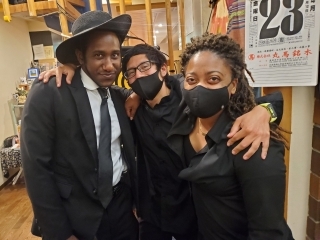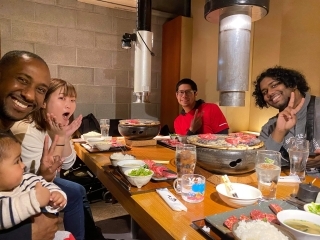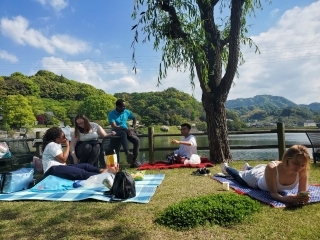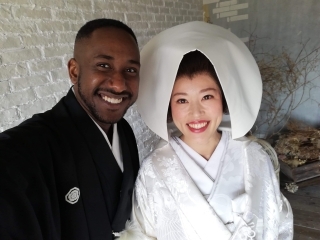JET Programme Series: Changing locations on JET & how it affected my lifestyle - Knikkoliev Seebaran
2021/10/19



JET Programme Series: Changing locations on JET & how it affected my lifestyle - Knikkoliev Seebaran

I have been an ALT for 3 years and I am one of the rare few to successfully transfer to a new location while being on the JET programme. Because of this, I want to take this time to explain my experience and how it affected my life in Japan.
The transfer process is a bit tedious. In this programme, all ALTs have to option to make a request for a transfer but a valid reason is needed to be successful. Since a city is investing in you to be there, it’s a very difficult decision for them to let you go to another city. That being said, you must have a very strong reason why you’re transferring. The top three reason for a successful transfer is, Marriage, Medical or a serious emergency (other). During the time I was getting married, I was successful in obtaining approval for the transfer and thus, living and working in a new area.
Moving wasn`t that bad. Luckily, with the help of my wife, friends, co-workers and not having much things, I was able to move everything to my new home without any hassle. Having great relationships with people around me really help with living in Japan, more so, getting things done in a timely manner. In two trips, all my things were quickly cleared out of my old apartment that my supervisor was surprised.
Culture shocked between two places.
Lifestyle
I’ve lived in Imabari for 2 years and the relationships I made there were unforgettable. I’ll always cherish them. Free mikan (oranges) during summer time, dinner nights with strangers, biking through the city and conversations with my favourite Lawson family (the convenience store next to my apartment). My life in Imabari was a dream that came true. Now, my new life is split between my new home in Kan-onji, Kagawa and my schools in Mishima, Shikokuchuo. With this split, a car was required to travel between these places. My one-hour drive between them has limit my exploration to a quick glance of the outside world while I swish by in my car. My new life also has given me new responsibilities that requires more of my time to focus on the family and little on the environment around me. Equivalent exchange, I guess. Although I`m happy in one aspect of my life, with love and family, I’m a little sad that I lost a lot of my exploration time. One of the aspects of being an ALT isn`t just to work hard, but to get the opportunity to embrace the culture of Japan and I think some people forget that while on the program.
Interacting in workforce
In Imabari, the teachers there at the time, were very eager to talk to me. With very little to no English, teachers would ask me simple questions like “do you oranges?” or “why Japan?”. At first, I would get annoyed because there were more to me than knowing what fruits I like or why I’m here. After spending more time studying Japanese, I started doing the same to them in Japanese and it created a bond that I least expected since this was my first time truly interacting with someone that’s completed opposite from my culture. Over time, it became a daily trend to pass by each other and at least say “hi, how are you?”. Relationships blossomed and eventually, it felt like home.
Moving to Mishima, there was a shift in the dynamic. I believe, since teachers knew I’ve been here for a while, they seemed to have some level of expectation of my capabilities so there was very little effort made on their end to converse with me. As most people should know, Japan culture is a very busy atmosphere so there’s very little time to really interact unless it's something important or there’s a “drinking party”. I’m guessing that Imabari culture was a gem in the rough where it is more of a relaxed community which is very rare to find in Japan. This is to say, this is my first time experiencing the true side of “the busy Japan life”. I would quickly say good morning to teachers and then sit by my desk. Afterwards, its goodbye and I’m out. There are the rare occasions when a teacher would ask about my country or what classes do I have next. On the other hand, there isn’t any hostility towards me. I still get the usual head-nods and smile. It may take me some time to start from scratch to build relationships but at the moment, it’s not bad.
The area
Imabari is popular for three main things, Mikan, biking and the Shimanami bridge. If you ask anyone there, they would quickly say these things. I would say that it’s the city for active people. Everywhere you go, its best that you bike and cruise through the city, feel the wind and enjoy the coastline.
Shikokuchuo is mainly popular for the Paper Factory. You can see it from a distance with white smoke coming out of its chimneys. When speaking to the locals, that’s mostly what I hear and recommendations for restaurants with delicious food. Although there’s a charm to this place, it still requires a bit of driving to get around.
Both places do share the same beauty of its environment with very spacious parks and well-crafted castles but it really comes down to what you’re attracted and how willing you are to go out and explore.
Ill keep you posted.
JET Series: Changing location on JET & how it affect my lifestyle (Japanese Embassy's Facebook)
JET Programme Series Archives
The transfer process is a bit tedious. In this programme, all ALTs have to option to make a request for a transfer but a valid reason is needed to be successful. Since a city is investing in you to be there, it’s a very difficult decision for them to let you go to another city. That being said, you must have a very strong reason why you’re transferring. The top three reason for a successful transfer is, Marriage, Medical or a serious emergency (other). During the time I was getting married, I was successful in obtaining approval for the transfer and thus, living and working in a new area.
Moving wasn`t that bad. Luckily, with the help of my wife, friends, co-workers and not having much things, I was able to move everything to my new home without any hassle. Having great relationships with people around me really help with living in Japan, more so, getting things done in a timely manner. In two trips, all my things were quickly cleared out of my old apartment that my supervisor was surprised.
Culture shocked between two places.
Lifestyle
I’ve lived in Imabari for 2 years and the relationships I made there were unforgettable. I’ll always cherish them. Free mikan (oranges) during summer time, dinner nights with strangers, biking through the city and conversations with my favourite Lawson family (the convenience store next to my apartment). My life in Imabari was a dream that came true. Now, my new life is split between my new home in Kan-onji, Kagawa and my schools in Mishima, Shikokuchuo. With this split, a car was required to travel between these places. My one-hour drive between them has limit my exploration to a quick glance of the outside world while I swish by in my car. My new life also has given me new responsibilities that requires more of my time to focus on the family and little on the environment around me. Equivalent exchange, I guess. Although I`m happy in one aspect of my life, with love and family, I’m a little sad that I lost a lot of my exploration time. One of the aspects of being an ALT isn`t just to work hard, but to get the opportunity to embrace the culture of Japan and I think some people forget that while on the program.
Interacting in workforce
In Imabari, the teachers there at the time, were very eager to talk to me. With very little to no English, teachers would ask me simple questions like “do you oranges?” or “why Japan?”. At first, I would get annoyed because there were more to me than knowing what fruits I like or why I’m here. After spending more time studying Japanese, I started doing the same to them in Japanese and it created a bond that I least expected since this was my first time truly interacting with someone that’s completed opposite from my culture. Over time, it became a daily trend to pass by each other and at least say “hi, how are you?”. Relationships blossomed and eventually, it felt like home.
Moving to Mishima, there was a shift in the dynamic. I believe, since teachers knew I’ve been here for a while, they seemed to have some level of expectation of my capabilities so there was very little effort made on their end to converse with me. As most people should know, Japan culture is a very busy atmosphere so there’s very little time to really interact unless it's something important or there’s a “drinking party”. I’m guessing that Imabari culture was a gem in the rough where it is more of a relaxed community which is very rare to find in Japan. This is to say, this is my first time experiencing the true side of “the busy Japan life”. I would quickly say good morning to teachers and then sit by my desk. Afterwards, its goodbye and I’m out. There are the rare occasions when a teacher would ask about my country or what classes do I have next. On the other hand, there isn’t any hostility towards me. I still get the usual head-nods and smile. It may take me some time to start from scratch to build relationships but at the moment, it’s not bad.
The area
Imabari is popular for three main things, Mikan, biking and the Shimanami bridge. If you ask anyone there, they would quickly say these things. I would say that it’s the city for active people. Everywhere you go, its best that you bike and cruise through the city, feel the wind and enjoy the coastline.
Shikokuchuo is mainly popular for the Paper Factory. You can see it from a distance with white smoke coming out of its chimneys. When speaking to the locals, that’s mostly what I hear and recommendations for restaurants with delicious food. Although there’s a charm to this place, it still requires a bit of driving to get around.
Both places do share the same beauty of its environment with very spacious parks and well-crafted castles but it really comes down to what you’re attracted and how willing you are to go out and explore.
Ill keep you posted.
JET Series: Changing location on JET & how it affect my lifestyle (Japanese Embassy's Facebook)
JET Programme Series Archives
